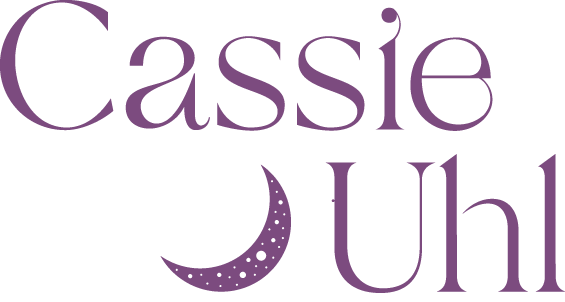- Astrology
- Auras
- Beltane
- Breathwork
- Candle magick
- Card spreads
- Cassie Uhl
- Chakras
- Cleansing
- Crystals
- Dark moon
- Death Care
- Divination
- DIY
- Dreams
- Elements
- Empath
- Energy work
- Free download
- Full moon
- Goddess
- Grief
- Handmade
- Herbs
- How-to
- Imbolc
- Intuition
- Journaling
- Letting go
- Litha
- Lughnasadh
- Mabon
- Magic
- Mantras
- Meditation
- Moon phases
- Mudras
- New moon
- Numerology
- Oracle
- Ostara
- Palmistry
- Plant Allies
- ritual
- Rituals
- Runes
- Sacred geometry
- Samhain
- Seasonal magick
- Shadow work
- Spellwork
- Symbolism
- Tarot
- The Ritual Deck
- Waning moon
- Waxing moon
- Wellness
- Wheel of the Year
- Winter Solstice
- Witchcraft
- Yoga
- Yule
- Zodiac
- air
- apple magic
- apples
- aquarius
- aquarius card spread
- aquarius ritual
- aquarius season
- aries
- astrology
- aura protection
- auras
- autumn equinox
- beltane
- cancer
- cancer season
- candle dressing
- candle magic
- candle magick
- capricorn
- card spread
- cast a circle
- casting circles
- cauldron
- Ceres
- chakra energy
- chakras
- channeling
- charging
- cleansing
- correspondences
- creosote
- Creosote
- crone
- crystal healing
- crystals
- death doula
- death positivity
- death work
- Demeter
- divination
- diy
- dream ritual
- dream rituals
- dream work
- dreams
- dreamwork
- eam
- earth
- eggs
- elements
- emotion code
- empath
- energy
- energy cleansing
- energy protection
- energy work
- fall equinox
- feeling auras
- fire
- four elements
- free meditation
- full moon
- full moon energy
- full moon in gemini
- full moon in pisces ritual
- full moon in scorpio eclipse
- full moon ritual
- gemini
- gemini card spread
- gemini season
- goddess
- grandmothers
- gratitude
- Great mother
- grief
- grief tending
- harvest season
- heart chakra
- herbal magic
- herbal magick
- herbal magick 101
- herbs
- high priestess
- house cleansing
- imbolc
- improving intuition
- infertility
- infertility awareness
- intuition
- intuitive healing
- jen isabel friend
- kunzite
- lammas
- learning tarot
- leo
- leo season
- letting go
- libra
- libra season
- lughnasadh
- Lulu Tineo
- mabon
- manifesting
- meditation
- moon phases
- mother meditation
- mother's day
- new moon
- new moon card spread
- new moon in capricorn
- new moon in leo
- new moon in libra
- new moon meditation
- new moon ritual
- north
- nurturing mother
- oracle
- oracle card spread
- ostara
- pendulum
- pendulums
- Persephone
- pineal gland
- pisces
- pisces full moon ritual
- plant connection meditation
- Plant magic
- popular
- protection magic
- protection magick
- reiki
- releasing
- residual energy
- resiliency
- ritual
- samhain
- scorpio
- scorpio season
- scrying
- seasonal magic
- seeing auras
- shadow work
- shamanic healing
- sigil
- smoke wands
- spell bottle
- spellwork
- Spirits
- spiritual
- spring equinox
- tarot
- tarot myths
- taurus
- taurus season
- the four elements
- third eye
- triple goddess
- understanding the earth element
- virgo
- waning moon
- water
- water is life
- waxing moon
- what are death doulas
- wheel of the year
- winter
- winter solstice
- witch bells
- working with auras
- Yolia Botanica
- yule
- zodiac
7 Tarot Myths Debunked
In our culture, there is no shortage of myths about tarot. Many of us were raised with the perspective that tarot cards are “scary” or that they have something to do with the devil.Misinformation is rampant, but the truth is, tarot can be a powerful tool to help you hone your intuition, connect with yourself, deepen your relationship with spirit/universe/guides, make decisions, and more. In this post, I’ll be debunking some major myths about the tarot so that you can feel freer to work with the tarot in a way that feels really good to you.

In our culture, there is no shortage of myths about tarot. Many of us were raised with the perspective that tarot cards are “scary” or that they have something to do with the devil.
Misinformation is rampant, but the truth is, tarot can be a powerful tool to help you hone your intuition, connect with yourself, deepen your relationship with spirit/universe/guides, make decisions, and more.
In this post, I’ll be debunking some major myths about the tarot so that you can feel freer to work with the tarot in a way that feels really good to you. Check them out below!

MYTH 1: YOU MUST BE GIFTED YOUR FIRST DECK
This is a super common myth! Have you ever heard that you can’t buy your own deck and you must be gifted your first deck?
Tarot reader and author Theresa Reed told Refinery 29 that this myth is “total rubbish.” She says, “If I would have waited around for that to happen, I might not have started working with the tarot as soon as I did — if ever.”
I feel the same way. To me, this myth is just a form of gatekeeping in the tarot community. No one is exactly sure where this myth comes from, but it may be a legacy of 19th-century closed occult societies.
Regardless of where it comes from, there’s nothing wrong with buying a deck for yourself — tarot is a folk magic practice, and it belongs to the people, so you don’t need permission from someone else in the form of a gifted deck to start your practice. If you feel attracted to working with the cards - pick yourself up a deck!
Give this post a listen here.
MYTH 2: TAROT IS EVIL
Another variation of this myth is that tarot cards have something to do with the devil. I believe this myth originates from Christianity. There are various verses in the Bible about divination, “sorcery,” and mediumship that have been translated to be a condemnation of all occult, divination, and spiritual tools outside of Christianity.
This myth is also often perpetuated by the media, whose portrayals of tarot readers and cards have often been abysmal. Media is intended to be sensational, which means tarot cards are portrayed as evil or used for devil worship. Common tarot scenes show the “scary” cards with literal meanings - like the death card when someone is going to die or the devil card when something evil is going to happen.
This myth is easy to debunk when I ask myself a few questions:
Who benefits from me believing this myth (whether it’s dogmatic religion that wants me to rely on their truth rather than find my own through a tool like the tarot or a TV show that wants to make interesting TV and get viewers)?
Do I really think that Barnes and Noble are selling a tool to connect with the devil?
What have my experiences with the tarot been like?
Like with most things, we can use tarot in helpful ways and not so helpful ways. But the cards are not inherently evil, and we can use them in ways that support ourselves and our highest good.
MYTH 3: THE DEATH CARD MEANS YOU’LL DIE
Ah, another TV myth. Like I mentioned above, this card is often portrayed as a super scary card, and when it shows up in a reading, it could mean you’re going to die.
All tarot cards are neutral. There are no good or bad cards. Some cards may be more uncomfortable than others (and this will change depending on every person!), but no cards are in and of themselves bad.
So no, the death card doesn’t mean you’ll die. Usually, it means a transformation of some kind. It refers to deaths of a different kind - deaths of relationships, ways of being, of selves you have been, dreams, etc.
In the United States, we have a cultural aversion to the idea of death, and I think we disconnect from the idea of death happening all around us all the time throughout our lives. The death card breaks this fiction and reminds us that death is a natural process unfolding throughout the seasons and throughout our lives and that it clears the way for our evolution and growth.
That can be scary, too, of course - change is often hard. But next time you pull the death card, you can lean into that kind of scary and not worry that you’re going to die literally.
MYTH 4: TAROT IS ONLY USED TO TELL THE FUTURE
Tarot can certainly be used to predict the future. But in my belief, the future is not set. The future is always changing, and we are actively creating it with our energy and our decisions each day.
When I pull more predictive cards, I like to remember that I have the power to change the future and make different decisions if I don’t like the outcome card in front of me. This is a way to use tarot that feels more empowering and more honest.
But more often than not, I’m not using tarot cards to tell the future, and I think many modern readers will tell you the same. Fortune telling is one powerful way to use the tarot. Still, there are many other ways to work with the cards that can be even more powerful, in my opinion: to connect with yourself, to understand your inner world, to process feelings, to understand current energies, to make support decisions, to connect with your intuition, to heal, and more.
MYTH 5: YOU NEED TO BE PSYCHIC TO READ THE TAROT
I think this myth is rooted in the previous one: that tarot is only used for fortune-telling. When we know that tarot has many purposes, we understand that you don’t need to be psychic to read the cards.
You don’t need to be psychic to connect with your intuition, which is the most important piece of reading cards, in my opinion. Intuition can sometimes require some uncovering and trust work (click here for 3 daily actions to improve your intuition and here for 5 tips to learn how to trust your intuition), but it is innate and available to us all.
Reading the cards with your intuition could look like noticing how you feel about certain cards, paying attention to memories or images that come up around cards when you pull them (even if they don’t match with the traditional meaning of the cards), or meditating with cards to receive messages from them.
But regardless, tarot cards have meanings. You can study those meanings from different books and teachers and develop a rich and fulfilling tarot practice this way! As you learn to trust your intuition a bit more, weaving that practice into your work with your cards can add another meaningful layer.
MYTH 6: YOU CAN NEVER LET ANYONE ELSE TOUCH YOUR TAROT CARDS
This myth is rooted in the idea that the cards themselves contain magic or are magical. In my opinion, the cards themselves are a neutral tool and conduit. They don’t contain their own magic; youare the magic. So it doesn’t matter if other people touch them because they can’t take anything away from them.
If you don’t like other people touching your cards, that’s totally fine! But there’s no need to keep others from touching your cards out of fear that it will take away the deck’s magic or shift the cards' energy irreversibly.
In fact, many readers (myself included) like to have the querent shuffle the cards to infuse their energy and intention into the deck for a more powerful reading. If you feel the same, a regular cleansing process with your deck (click here to learn how to cleanse your cards) is all you need to keep your deck’s energy clear.
MYTH 7: REVERSED CARDS ARE BAD
When a card is reversed, that simply means it came out of your deck upside-down. Reading reversed cards in the first place is a matter of preference: some readers read them, and some will just flip the cards right side up and go with that meaning. As with most things tarot and intuition, there’s no right or wrong answer. Just do what works for you!
But whether you choose to read reversals or not, reversed cards are not inherently bad. They bring a different energy, certainly, and can add a layer of clarity to a reading, but they’re nothing to be afraid of. Reversed cards can mean blocked energy, more introspective energy, a softer meaning of the card, or maybe some fear around that card’s theme.
WANT TO LEARN MORE ABOUT THE TAROT?
Check out some of our other tarot blog posts:
6 Ways to Work With Your Tarot Cards Besides Divination
Divination is a fantastic way to work with the tarot, but you’re selling yourself short with your trusted tarot deck if you’re only using it to glean insights into the future. At its core, and in my opinion, the tarot is a powerful self-reflective tool. It’s here to share insights and guidance about what’s going on with you right now, at this moment. Telling the future is one of the most common draws to tarot, but the tarot truly brings a host of other benefits.Read on for six ways to work with the tarot to grow and expand in new ways, aside from divination.
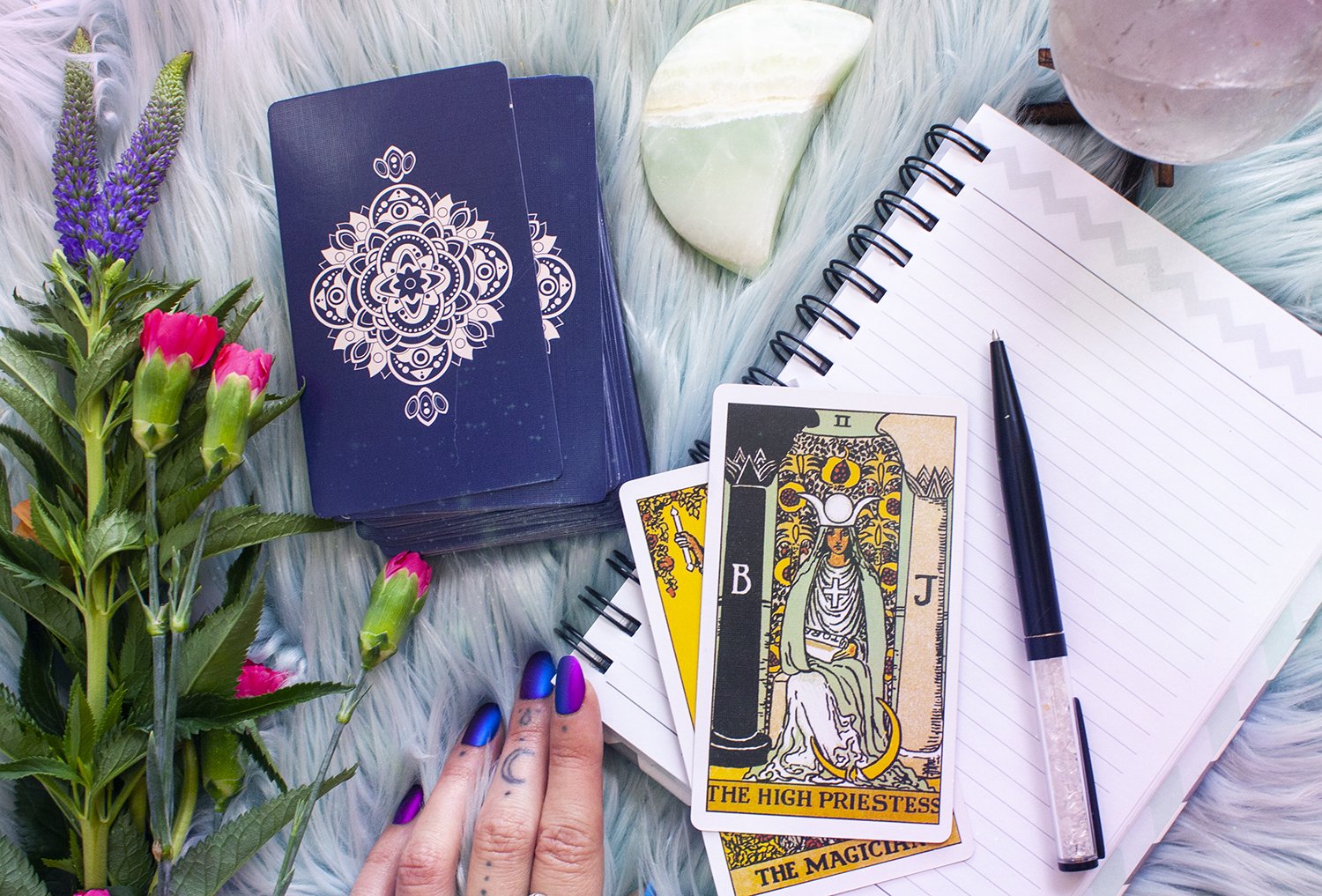
Divination is a fantastic way to work with the tarot, but you’re selling yourself short with your trusted tarot deck if you’re only using it to glean insights into the future. At its core, and in my opinion, the tarot is a powerful self-reflective tool. It’s here to share insights and guidance about what’s going on with you right now, at this moment. Telling the future is one of the most common draws to tarot, but the tarot truly brings a host of other benefits.
Read on for six ways to work with the tarot to grow and expand in new ways, aside from divination.

Working with Common Archetypes
The tarot is full of common archetypes that you will encounter or embody at different times in your life. Archetypes are timeless and universal energies that people can understand across cultures. For example, the archetype of the mother is something we can all understand on some level. Even if you do not have a relationship with your biological mother or have children of your own, the overarching energy of the archetype of the mother is something you can understand. Furthermore, you do not have to be a mother or a woman to embody the mother's archetype. Anyone can access and learn from the energy of motherhood.
The tarot is dripping with common archetypes, especially in the major arcana. The way the archetypes show up can be personal and vary from person to person. Most of the common archetypes appear in the major arcana, but they can also be found in the minor. Here are some of the archetypes I associate with the cards: the ego (the sun), soul (the moon), mother (empress), father (emperor), wizard (magician), child (the fool), lover (the lovers), martyr (hanged one), seer (hermit), and authoritarian (hierophant), etc. You may decide on different archetypal associations with different cards, and that’s fine.
So, how can you work with the archetypes of the tarot? Lots of ways! You can explore how the archetypal energies associated with the cards make you feel, you can look at the symbology on each card and explore how it makes you feel about its archetype, you can journal about the cards and their archetypal connections, and you can layer it into how you interact with and understand the cards.
Journaling
Journaling allows you to dive deep into the meaning and energy of each card. You’ll better understand the lessons each card wants to offer you through journaling about them. Truth be told, I’m not a big fan of journaling. Journaling with the tarot is different, though. I always write when I pull cards for myself. To begin journaling with the cards, you can work through them one at a time in order or intuitively select a card to journal about. Here are some suggestions for questions to ask yourself when you’re journaling about different cards:
How does this card make me feel?
What symbols or imagery jumps out to me?
Are there any archetypes or human themes that stand out to me in this card?
How does this card show up in my life right now?
What can I learn from this card?

Energy Readings
If you’ve followed my work long, you already know that I love all things energy! We are energy beings, and the tarot is another magical and beautiful way to work with your energy. What do I mean by this? Tarot is an excellent tool for reading your energy and understanding how to balance your energy.
Each card in the tarot corresponds with different energy. When you work with the cards specifically to assess your energy, the cards can act as a guide for what kind of energy you may need more or less of. Each card's energy can act as a signal that you either have too much or too little of that energy.
For example, if you pull some cards to determine what your energy needs to be more balanced and you pull loads of pentacles, that would be a sign that you need more grounding in your life to feel more balanced because the pentacles relate to the element of earth.
You could also consider pulling a card for each energy center or chakra in your body to get an idea of what each energy center needs to be in better balance. I dive into this more in-depth in my book, The Zenned Out Guide to Understanding Tarot.
Exploring and Understanding Common Correspondences
If you’re a visual learner, like I am, you’ll love working with the tarot to understand common correspondences better. I won’t spend too much time talking about this here because I already covered this in a previous post here.
Basically, each of the cards has a handful of correspondences (correspondences are simply energies that match or “play well together.”) The most common correspondences are the elements, astrological energies, and numerology. I’ve found that using the tarot as a tool to understand different types of energies better is immensely helpful, especially for visual learners. The cards' symbology and meanings will add a depth of understanding to your astrology, numerology, or elemental practice. You’ll also learn the tarot card meanings faster as well.
Shadow work
The cards of the tarot contain a complete range of human experiences. It does not gloss over the hard, scary, and sometimes earth-shattering parts of life. This is one reason why, I believe, so many are nervous about diving into tarot. It’s also why it can be such a powerful healing tool.
Your cards will not shield you from your shadow. Instead, they call you to cozy up to your shadow to understand better what it has to teach you. If the idea of shadow work is new to you, check out this previous post to learn more about what shadow work is. Here are a few ways to dive into shadow work using your tarot card deck.
Journal about the cards that make you the most uncomfortable. Use the questions above from the journaling section.
Ask questions specifically to explore your shadow, like “What parts of my shadow need healing and exploring?”, “ What do I have to learn from my shadow?” or “What parts of my shadow have I been avoiding?”
Spellwork & Magick
If you’re a fan of spellwork, altars, or magick, this one’s for you (it’s also another one of my favorite ways to work with my deck.) Because each tarot card carries a unique energy, they are perfect for adding energy and intention to spellwork, magick, and your altar. Here are a couple of ways to start working your cards into your magickal practice.
Place a card on your altar to invite in a specific kind of energy. For example, if you’re focusing on improving your intuition, you could place the moon, the high priestess, or the queen of cups on your altar as a reminder and energetic intention.
Add a card to your spell. For example, if you’re focusing on bringing more abundance into your life, you could include the nine of pentacles or the empress into your spell.

Want to learn more about working with the tarot? Order my book, The Zenned Out Guide to Understanding Tarot. Or, check out some of these posts: Understanding Tarot Correspondences, The Difference Between Tarot and Oracle, 7 Tarot Myths Debunked or Understanding Tarot Birth Cards.
6 Tips to Learn the Tarot Card Meanings Quickly
So you got your first tarot deck, did a couple of solo readings, and then never picked it up again? Or, you work with tarot regularly but find yourself frustrated with being so reliant on the guidebook? One of the biggest hurdles people face when getting started with tarot is learning the card meanings. This kept me from diving deep into the tarot for years, too; I get it!There are much easier techniques to learning the meanings of all of the cards besides memorizing a guidebook word for word for 78 different cards.

So you got your first tarot deck, did a couple of solo readings, and then never picked it up again? Or, you work with tarot regularly but find yourself frustrated with being so reliant on the guidebook? One of the biggest hurdles people face when getting started with tarot is learning the card meanings. This kept me from diving deep into the tarot for years, too; I get it!
There are much easier techniques to learning the meanings of all of the cards besides memorizing a guidebook word for word for 78 different cards. Not only is memorizing a guidebook of 78-card meanings not very feasible, but it’s also an intuitive disservice in working with the tarot.
What if I told you that you could have a robust knowledge of all 78 cards by learning only 36 correspondences? I know 36 is nothing to sneeze at, but here’s the thing, the 36 correspondences I’ll layout in this post will not only help you understand the energy of each tarot card but will also help you in nearly all other facets of spellwork and magick.
What are correspondences?
Correspondences are simply energies that play well together or match. Each card of the tarot has at least a couple of correspondences, and when you better understand each card's correspondences, you’ll also understand the energy of each card. The correspondences associated with tarot are not unique to tarot and relate to numerology, astrology, witchcraft, and more. Plus, there’s a good chance that you’re already familiar with some of the correspondences that I’m going to outline in this post. If you are, that’s great! You’re already a step ahead.
Before you dive in, correspondences and their meanings can be rich and deep. They can also vary somewhat from person to person. What I share here is enough to get you started to build a strong foundation, but I recommend digging deeper into the ones you’re less familiar with.
Dive deeper into tarot correspondences in my book, Understanding Tarot. You might also find that reading an introductory book on numerology or astrology will really deepen your understanding of those specific correspondences. You can also read up on numerology and the four elements right here on the blog! Click here for more on the elements and here for more on numerology.
Let’s dive in. Here are 6 tips to help you learn the tarot card meanings quickly.
1. Understand your learning style!
Before we jump into understanding the correspondences of tarot, you need to get super clear about how you learn and use that method as we dive into the correspondences. If you’re a visual learner, get a journal and start drawing and writing down what the correspondences below mean. If you’re an auditory learner, consider listening to an audiobook about the correspondences listed below. If you learn by doing, continue working with your tarot deck to weave this knowledge into your readings. Not sure how you learn best? Try a few different ways listed above and see what sticks.
2. Understand Basic Numerological Meanings
The largest part of a tarot deck, and for many, the trickiest cards to learn, are the numbered suit cards of the Minor Arcana (think 2 of cups and 4 of wands, etc.) Understanding the basic numerological meanings will make you feel MUCH more confident with these cards. There are ways to use numerology in the Major Arcana too, which you’ll be able to learn more about in my new book. For the minor arcana, use these numerological meanings to give you clues about what each card means.

New beginnings
Balance
Creativity
Foundations
Change
Partnership
Intellect
Mastery
Endings
This one is kind of unique to tarot because, in traditional numerology, you always reduce down to a single-digit between 1-9. Fortunately, the meaning often in regards to the tarot is pretty obvious. It points to an end of a cycle and transitioning to a new phase. It has a slightly different feel than 9 in that it signals a willingness to move on.
3. Understand the 4 Elements
Earth, air, water, and fire are, in my opinion, foundational in any magickal or divination practice. The elements are the energies that we’re made of and can be utilized in nearly all facets of a spiritual and magickal practice! Each of the four elements corresponds with a suit of the minor arcana, shown here.
Cups- Water
Pentacles- Earth
Swords- Air
Wands- Fire
Now that you know more about the meanings associated with the numbered cards of the minor arcana, you can also apply the corresponding element. Now you have two things to go off of to understand the energy of each card better. Here’s a list of how the energy of the elements express themselves.

There are ways to apply your understanding of the elements to both the minor arcana's court cards and the major arcana. I discuss these more in my book, but this is a great place to start!
4. Understand Zodiac and Planetary Meanings
We’ll begin to transition more to the major arcana for this one. Each of the major arcana cards corresponds with either a planet or a zodiac sign, giving it a unique energy.
The Fool - Uranus
The Magician - Mercury
The High Priestess - The Moon
The Empress - Venus
The Emperor - Aries
The Hierophant - Taurus
The Lovers - Gemini
The Chariot - Cancer
Strength - Leo
The Hermit - Virgo
Wheel of Fortune - Jupiter
Justice - Libra
The Hanged One - Neptune
Death - Scorpio
Temperance - Sagittarius
The Devil - Capricorn
The Tower - Mars
The Star - Aquarius
The Moon - Pisces
The Sun - The Sun
Judgment - Pluto
The World - Saturn
Here are examples of how these energies express themselves. Zodiac Signs

Planetary Meanings
Sun - Ego
Moon - Subconscious
Mercury - Communication
Venus - Love
Mars - Warrior
Jupiter - Expansion
Saturn - Restriction
Uranus - Revolutionary
Neptune - Dreams
Pluto - Transformation

5. Learn how Astrological Energies Correspond with the Elements
I imagine correspondences as a web of intersecting energies that play off of each other. When you understand how these different energies match up or repel each other, it will take your understanding of the tarot cards' meanings to a deeper level.
Each of the zodiac signs and planets corresponds to an element. Now, with your understanding of the elements and basic astrology, you can weave these meanings together. Here’s a list of how the planets, zodiacs, and elements correspond with one another.
Aries - Mars - Fire
Taurus - Venus - Earth + Water
Gemini - Mercury - Air
Cancer - Moon - Water
Leo - Sun - Fire
Virgo - Mercury - Earth + Air
Libra - Venus - Air + Water
Scorpio - Pluto - Water
Sagittarius - Jupiter - Fire
Capricorn - Saturn - Earth
Aquarius - Uranus - Air
Pisces - Neptune - Water
With this information combined, we can see that the Empress corresponds to Venus, the earth element, and Taurus. Therefore the Empress card relates to love, beauty, and creation from an earthly and material perspective.
6. Pair this Knowledge with your Intuition
Think of all of this correspondence knowledge as a way to bolster your intuition. They’re not the end all be all of learning the tarot, but they go a LONG way! The more comfortable and confident you become in understanding these correspondences, the easier it will be for you to intuit the card meanings for yourself and others without a guidebook. The correspondences are better than a guidebook because they give you nudges and insights about what the cards have to tell you, rather than a definitive answer.
Learn more about building up your intuitive muscles here in this previous post.
Now it’s time for you to put these tools into practice. Find a way to learn them that works for you, and watch your ability to understand the tarot card meanings flourish!
Understanding the Energy of Scorpio Season
Welcome to Scorpio season! Our fixed water sign, this archetype is here to help us transform darkness into light. Whether you have Scorpio placements in your birth chart or not, we’re all feeling into this energy during this season. In this blog, I’ll share what Scorpio is all about, the planetary and tarot associations of Scorpio, and how to understand Scorpio in your chart.
Understanding the Energy of Aquarius Season
You may know of Aquarius as a sign that’s innovative and eccentric. If you’re an Aquarius, you might be tired of seeing Aquarius stereotypes in every astrology meme on Instagram.While Aquarius is certainly innovative and unique, there’s so much more to this energy than meets the eye (or the meme).In honor of the Aquarius season starting on January 20th, I’ll be diving into Aquarius energy in this blog. I’ll be sharing what Aquarius energy is really about, the planetary and tarot associations of Aquarius, and how to understand Aquarius in your chart.
3 Rituals for Letting Go
What is your relationship with letting go?Ritual and magical practice can help us with more than manifesting, attracting, and calling in. It can also help us shed, let go, and transform ourselves and parts of our lives. The winter season invites us to incubate, release, and hibernate. It is an ideal time for release work (as well as the fall!). The phases of the moon that correspond to release are all the waning phases - the waning gibbous moon, the last quarter moon, the waning crescent moon, and the dark moon. Learn more about the phases of the moon with The Ritual Deck (pictured below.)
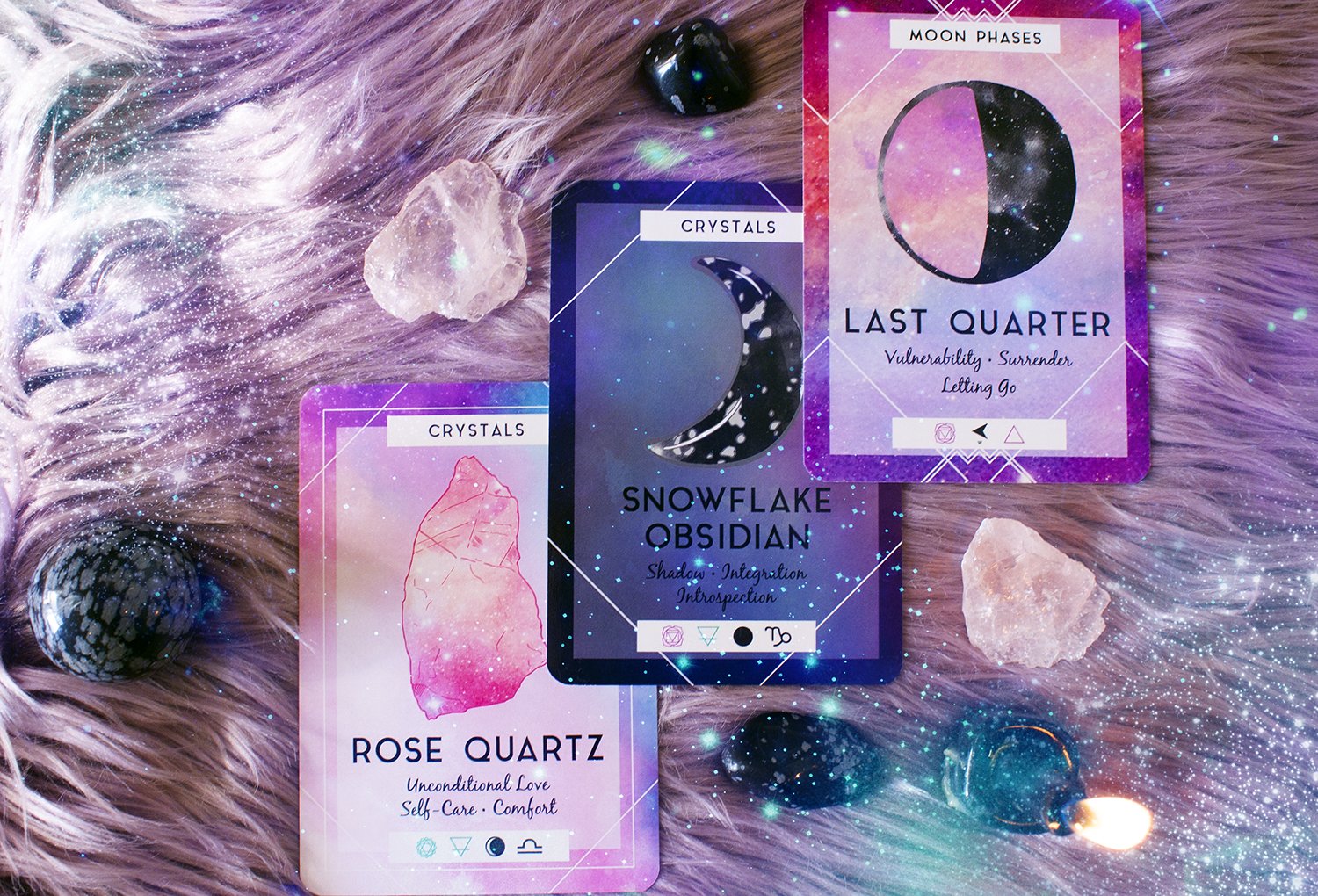
What is your relationship with letting go?
Ritual and magical practice can help us with more than manifesting, attracting, and calling in. It can also help us shed, let go, and transform ourselves and parts of our lives. The winter season invites us to incubate, release, and hibernate. It is an ideal time for release work (as well as the fall!). The phases of the moon that correspond to release are all the waning phases - the waning gibbous moon, the last quarter moon, the waning crescent moon, and the dark moon. Learn more about the phases of the moon with The Ritual Deck (pictured below.)
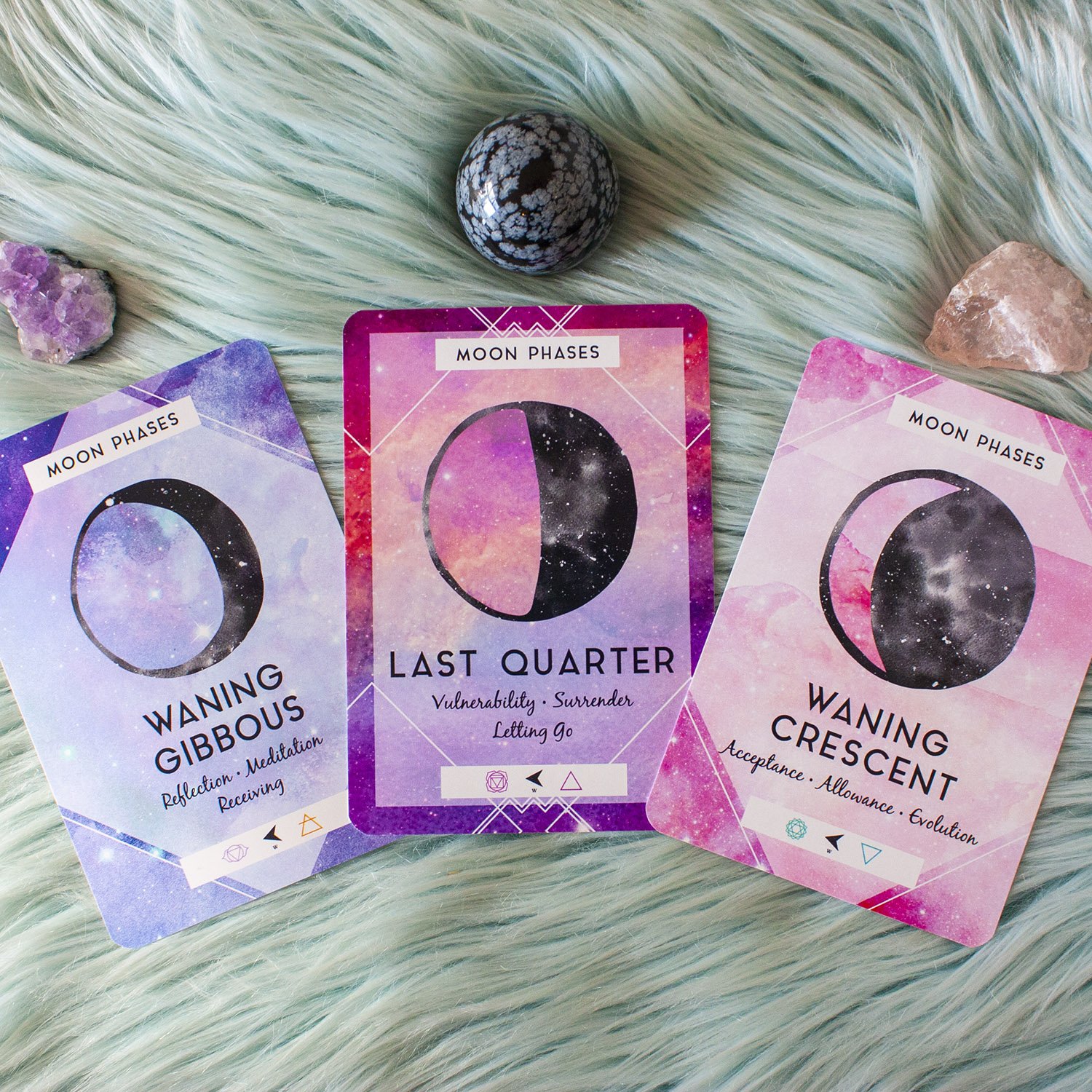
Before we get into the rituals, I also want to add that we can put a lot of pressure on ourselves to let go of things, and I want to honor that letting go can be really hard. Especially if what we’re letting go of has been something we have loved and cherished but is no longer a fit, feels comfortable, and/or feels safe.
So please, be gentle with yourself, be kind to yourself, and let release happen on your own timeline.
Keep scrolling to find a few rituals to support you in letting go.
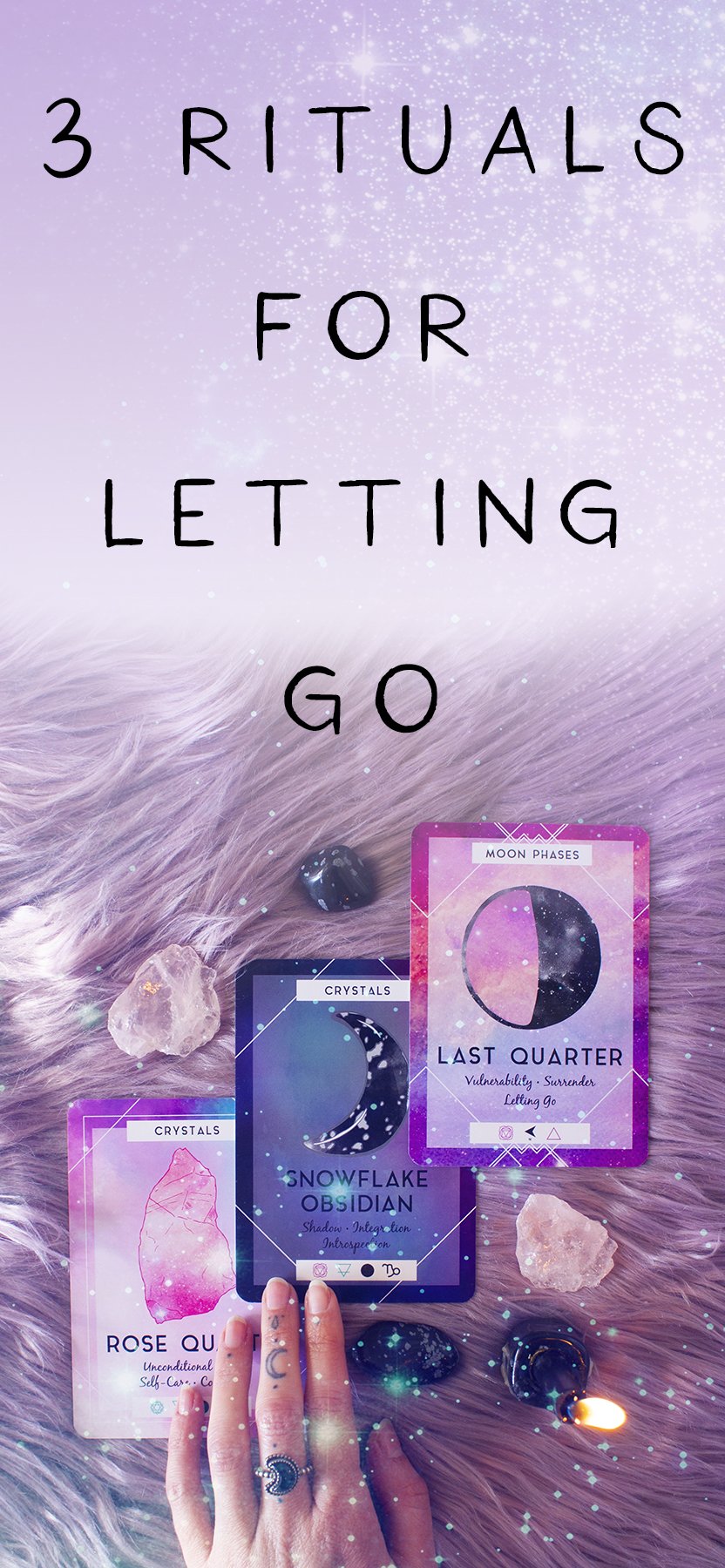
MOON RITUAL FOR LETTING GO
Our sweet, gorgeous moon is more than just an archetype, a deity, or energy. She is a real living body just like the Earth that we can go outside and look at, connect with, and talk to. I think sometimes we forget this but this is one of my favorite practices!
This is ideal to do when the moon is in its waning phases but still visible (so not the dark moon).
For this ritual, what you’ll need is yourself, an offering for the moon, and clarity on what you’re releasing. Your offering could be anything - a plate of your dinner, a glass of water, a branch, a flower, a drawing, a song - let your intuition guide you and go with what feels right.
When you have your offering, it’s ideal to go outside and sit or stand under the moon. If it’s really cold out or you don’t have space outdoors to do this, you can also sit by a window - that works just as well!
Take some time to center and ground yourself, entering a ritual space. Turn your gaze to the moon, ask to connect with her, and share your offering with her. Spend some time gazing at her and share your offering with her in whatever way feels good to you.
When you’re ready, tell her what you’re desiring to release. Ask for her help letting go. Sit in meditation, drawing down her energy and light through your crown and your whole body, letting this energy fill you up and either help you release whatever you’re desiring to release internally (blocks, fears, internal limits, ways of talking to self, etc), or charge you with the courage and power to release externally (a relationship, a job, a situation, project, etc.).
When you feel the energy shift, you know you’re finished! Thank the moon, ground yourself again, and spend some time journaling and processing afterward.
TAROT OR ORACLE SPREAD FOR LETTING GO
For this ritual, you’ll need your tarot or oracle deck and journal. Take some time to create a ritual space, whatever that means to you, and ground yourself before working with your cards. Set the intention to communicate with your highest self, spirit guides, ancestors, intuition, or any other deities or beings you had a relationship with.
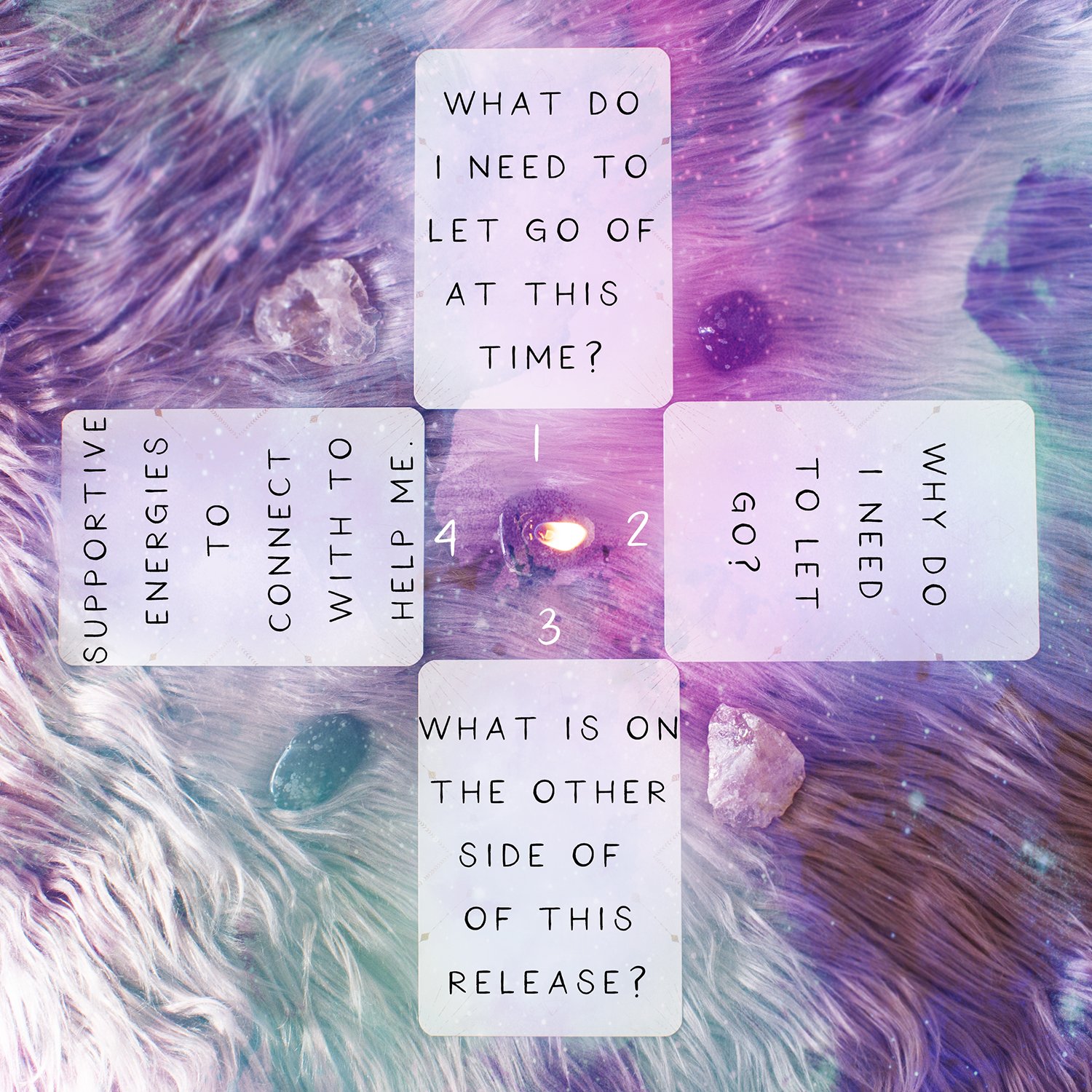
Once you’re fully present, shuffle your deck and pull cards for the following questions:
What do I need to let go of at this time?
Why do I need to let go?
What is on the other side of this release?
Supportive energies to connect with to help me let go.
Take your time with each card, really letting its messages move through you. I find it incredibly helpful to either meditate with my cards or journal about each card and what the spread means to me. I always get more information and a deeper understanding this way.
When you feel complete, it could be nice to add the cards to your altar - particularly the first and third cards - to support you throughout the release.
CANDLE MAGICK FOR LETTING GO
I love working with fire in spells and rituals, so naturally, I love candle magick! Fire is such a powerful element with its ability to transform and transmute - think of how fire turn logs into ash. It helps things change shape, die, and transform.
For this spell, you’ll need a black candle, a tarot card or oracle card representing what you’re releasing, and a safety pin to carve your candle.
Start by grounding yourself and casting your circle. Call in any supportive deities, guides, or other beings you have a connection with to join your circle and help you.
Next, you’ll want to intentionally choose the card from your deck that most represents what you’re releasing at this time. Take your time with this and really make sure you’re clear on what you’re desiring to release.
Once you have your card, it’s time to carve your candle. Carve into your candle any words and/or symbols that represent letting go to you. For example, I like to carve the glyph for Pluto into my candles when I work with releasing spells. Pluto represents change, rebirth, and transformation. Symbols and words work best when they’re personal to you, so don’t worry as much about the technical meaning and just intuitively choose what feels right to you!
Once your candle is ready, set it up with your card under it and take a few deep breaths. Speak your intention aloud as you light your candle, saying, “As I light this candle, I release X.” You might like to spend some time gazing into the candle flame as you focus on this intention.
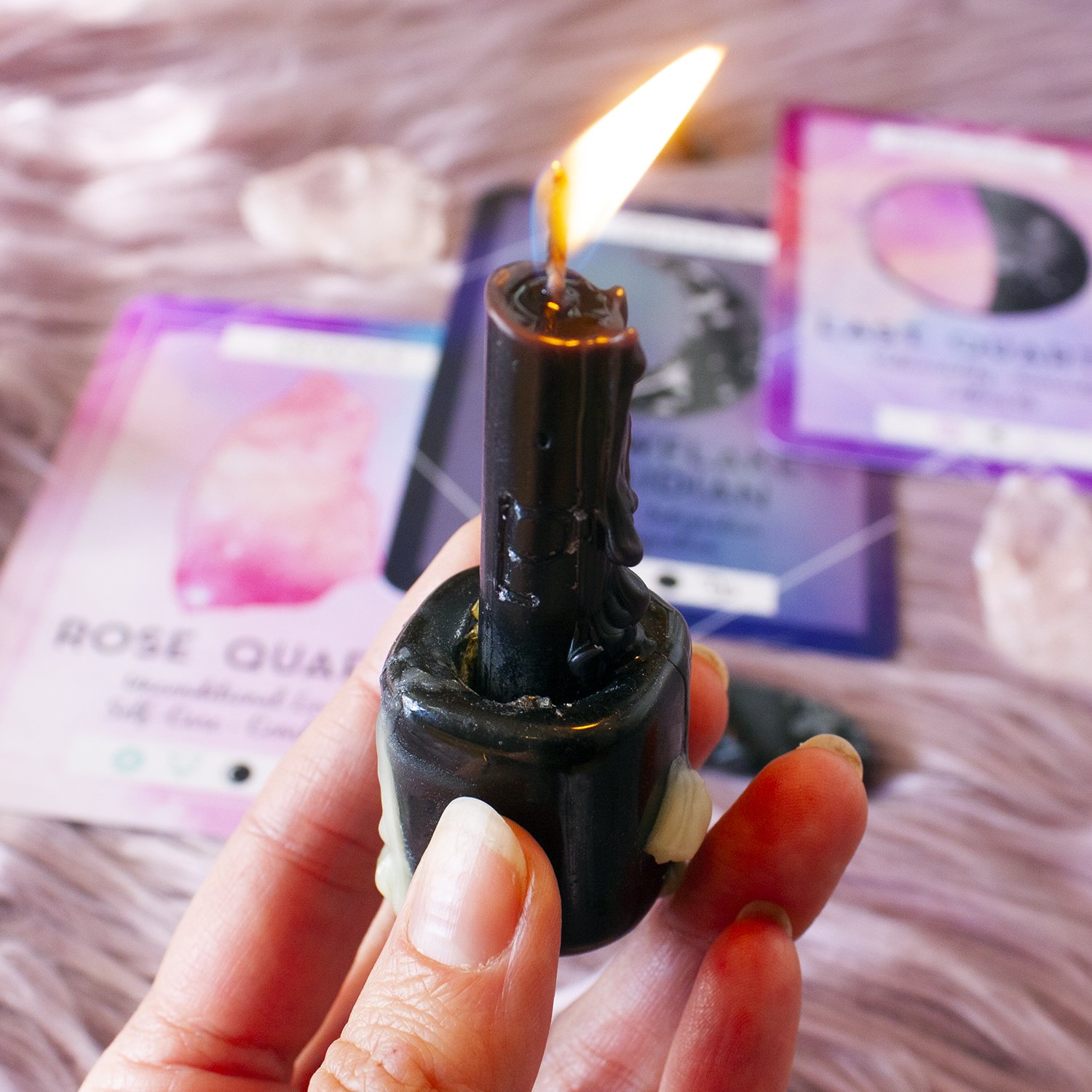
Then, it’s time to raise energy. You can raise energy however feels good to you - you might chant, sing, dance, do breathwork, or use any other tool that feels good to you. As your candle burns, you are raising energy in order to support this release.
When you feel the energy is at its peak, direct it with your intention towards releasing whatever it is you are releasing from your body, from your life.
When you feel complete, ground yourself again. Let the candle burn all the way down, thank any beings who joined you to help facilitate this release, and re-open your circle. Spend some time processing in your journal afterward, writing down what came up for you and what you felt.
